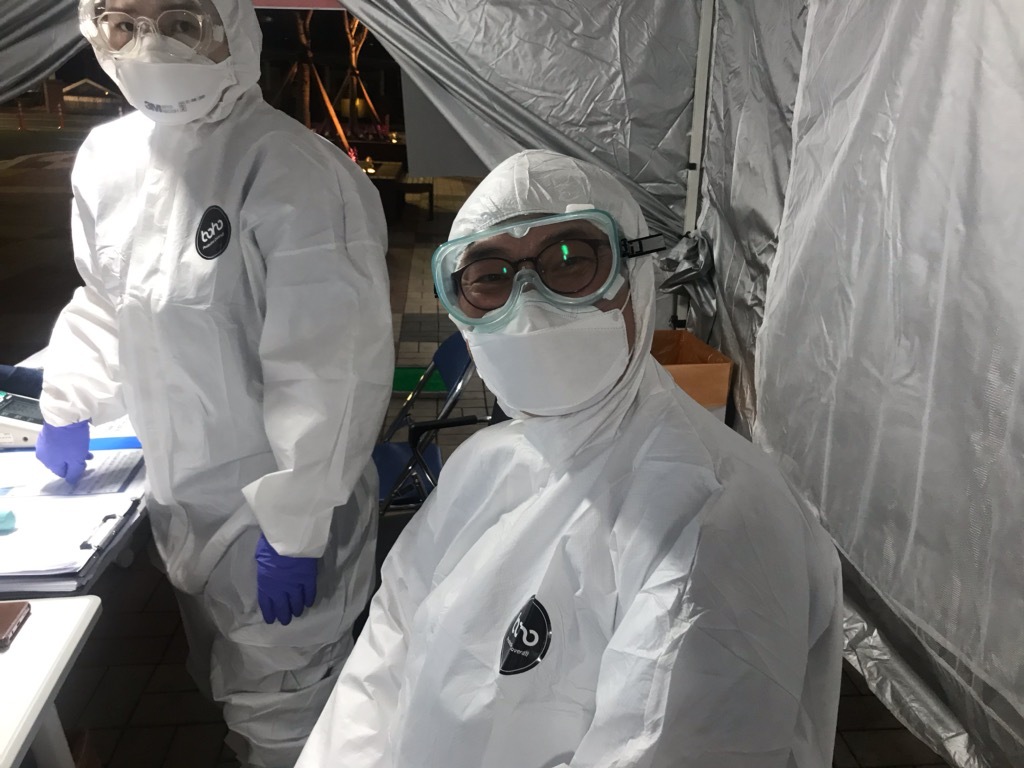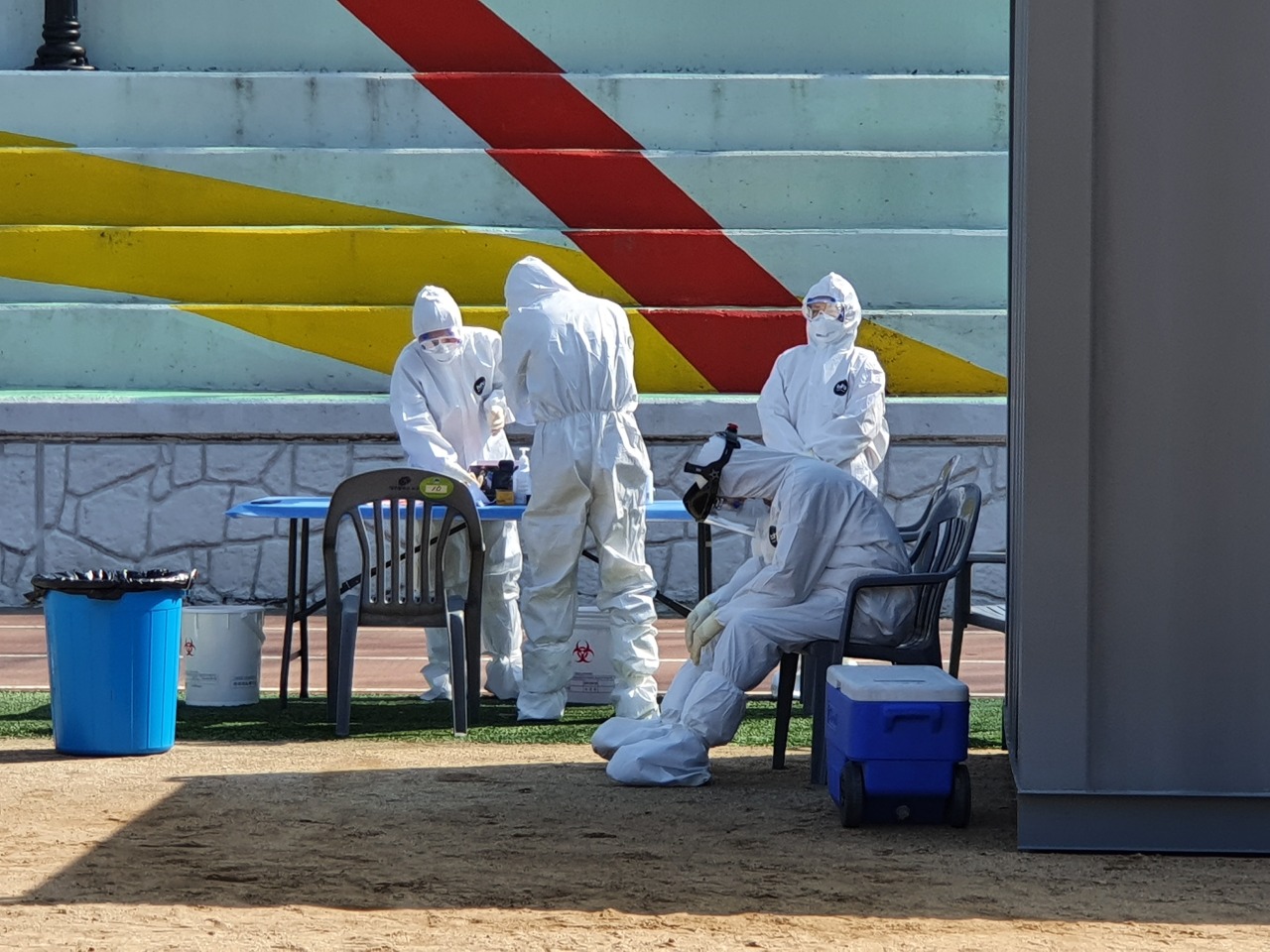[Herald Interview] Doctors face test of endurance in Daegu
‘Government measures should better reflect voices of health workers on front line’
By Kim ArinPublished : March 4, 2020 - 18:11

Doctors fighting the new coronavirus epidemic in Daegu, South Korea’s worst-affected city, face an uphill battle as shortages of supplies and beds add to the difficulties posed by a grueling schedule.
The official tally as of Tuesday midnight shows that 4,006 of Korea’s 5,328 confirmed cases of the new coronavirus are in Daegu and 774 in nearby North Gyeongsang Province. Over 90 percent of the 33 deaths took place in the southeastern city.
“I would be lying if I said I wasn’t scared,” Kim Eun-yong, a family physician who started volunteering Feb. 26, said in a phone interview Tuesday night.
Kim, who has run a clinic in the city’s southeastern district of Suseong for over 12 years, heads over for COVID-19 duty once he’s done seeing patients at his office at 6 p.m.
He said he is currently stationed at the coronavirus-only treatment center in Keimyung University Dongsan Hospital in Dalseo, a western Daegu district, but that he was constantly moving around, visiting different medical institutions around the city depending on where help is needed most.
“I know my schedules ahead for about a couple of days at most,” he said.
Because the protective suit is so hard to get out of, he and other medical workers often forgo proper meals, he said, opting instead for quick snacks like cup noodles.
“We get a lot of lunch boxes and food sent our way from donors and restaurants in the area,” he said. “But seeing as it’s hard to dine in between shifts, we are forced to turn some of them down.”
Asked what was the hardest thing about his job, he said it was the uncertainty.
“Every epidemic has its peak, but so far the infections keep rising, and quickly,” he said. “It is frightening.”
He said even doctors couldn’t tell from symptoms alone if a patient was infected.
“You absolutely have to be tested to know if you have the virus or not. This is not like the flu.”

Being exposed to the risk of becoming infected was also something Kim and his colleagues had to accept, working closely with the patients.
At the hospital where he is, there were only around 2,000 protective suits for the entire staff, which is enough to last just about four days, he said.
Although the Health Ministry, to overcome shortages, has advised health personnel to wear surgical gowns as opposed to the body suits worn now when collecting samples from patients, Lee warned that would be “extremely dangerous” and something the medical association was officially against.
“Had the Health Ministry asked one health expert, it wouldn’t have come up with guidelines like that,” he said. “The ministry officials should try collecting samples in that gown.”
Another thing that was hard for Kim was seeing medical attention delayed for non-virus patients.
“When a suspected virus patient comes to the emergency room, the care for other patients is kind of put on hold due to infection concerns,” he said, asserting the need for separate wards for virus and non-virus patients.
President of the Daegu Medical Association Lee Seong-gu told The Korea Herald that thanks to health workers who have come to volunteer from all over the country in the past few weeks, the doctor shortage has eased -- at least for now.
“Last count we had was about 350 doctors (volunteering), but there are more at hospitals, emergency rooms and other facilities in the city responding to needs as they come,” he said.
But protective equipment such as face masks and suits were running out with no apparent way to purchase new ones, Lee said, adding that they were mostly relying on donations.
While Deputy Prime Minister Hong Nam-ki said during Tuesday’s parliamentary interpellation session that hospital bed shortages in Daegu and North Gyeongsang Province have been “resolved for the most part,” Lee said it was far from true.
“There are still too many patients who cannot be accommodated at hospitals,” he said.
Lee said about 110 doctors are offering phone consultations to nearly 2,000 virus patients in home isolation -- each covering about 10 to 20 patients -- to keep tabs on their condition.
“This is so that the patients at home are not completely neglected,” he said. The doctors alert health authorities if the patients are not improving, or if they get worse.
Bang Sang-hyok, who is directing the Korean Medical Association’s support efforts to Daegu, said he hoped the voices of medical workers in the field would be heard by the decision-makers at the top.
“We have to listen to the people who have the most understanding of this new disease from seeing the patients on a daily basis,” he said. “Otherwise, the measures that end up being implemented are not only unhelpful, but can present even more of an obstacle for those who are on the front line.”
Bang, who came to Daegu on Feb. 27, has been working at a drive-thru clinic in western Daegu, a service that is expected to be set up at more stops in the city.
He added that while the majority of the infections are in Daegu, other regions, especially densely populated Seoul, should be more aggressively tested.
“From clinical observations, about 8 in 10 virus patients show mild symptoms. The only way to know if they are infected, and keep them from transmitting the disease to others, is to test them,” he said.
By Kim Arin (arin@heraldcorp.com)







![[Graphic News] More Koreans say they plan long-distance trips this year](http://res.heraldm.com/phpwas/restmb_idxmake.php?idx=644&simg=/content/image/2024/04/17/20240417050828_0.gif&u=)
![[KH Explains] Hyundai's full hybrid edge to pay off amid slow transition to pure EVs](http://res.heraldm.com/phpwas/restmb_idxmake.php?idx=644&simg=/content/image/2024/04/18/20240418050645_0.jpg&u=20240419100350)






![[From the Scene] Monks, Buddhists hail return of remains of Buddhas](http://res.heraldm.com/phpwas/restmb_idxmake.php?idx=652&simg=/content/image/2024/04/19/20240419050617_0.jpg&u=20240419175937)

![[KH Explains] Hyundai's full hybrid edge to pay off amid slow transition to pure EVs](http://res.heraldm.com/phpwas/restmb_idxmake.php?idx=652&simg=/content/image/2024/04/18/20240418050645_0.jpg&u=20240419100350)

![[Today’s K-pop] Illit drops debut single remix](http://res.heraldm.com/phpwas/restmb_idxmake.php?idx=642&simg=/content/image/2024/04/19/20240419050612_0.jpg&u=)